Stockholm Syndrome & 7 tips for Stockholm
Self-isolation and social distancing have provided me with the perfect excuse to stay home, binge watch on TV series and films, read, and write. One of the TV series I’ve recently watched is ‘La Casa De Papel’ (or ‘Money Heist’ in English), a Spanish TV series available on Netflix. The latest episodes (Part 4) have just been released on 3 April 2020. In Parts 1 and 2, a group of robbers breaks into the Royal Mint of Spain, in Madrid, taking 67 hostages. During the robbery, one of these hostages falls in love with one of the robbers and subsequently becomes an accomplice to the group. A classical example of the so-called Stockholm Syndrome.
So, what is the Stockholm Syndrome?
Stockholm syndrome refers to a psychological phenomenon where a hostage develops positive feelings towards their captors (during a period of captivity). Despite its medical-sounding name, the Stockholm Syndrome is not considered a mental illness or a psychiatric disorder, and is not included in the Diagnostic and Statistical Manual of Mental Disorders (DSM) or the International Classification of Diseases (ICD), the most widely used publications for the classification of mental disorders. The term was coined in 1973 by Nils Bejerot, a Swedish criminologist and psychiatrist, following a bank robbery in Kreditbanken, one of the largest banks in Stockholm. When the four hostages were released after 6 days of captivity, none of them would testify against their captors in court; instead, they began raising money for their defense.
This is neither the first nor the only example of this psychological phenomenon. In fact, the FBI’s Hostage Barricade Database System and Law Enforcement Bulletin indicate that roughly 8% of victims show evidence of the syndrome.
Stockholm Syndrome in the Arts
Stockholm Syndrome has fascinated many writers and artists. In fact, ’La Casa De Papel’ is not the only drama that refers to the eponymous syndrome. Directed by Robert Budreau and starring Ethan Hawke, the 2018 film ‘Stockholm’ (also known as ‘The Captor’ in some countries) is based on the true story of the bank robbery in Kreditbanken.
Quite a few musicians have also written and performed songs inspired by the Stockholm Syndrome, including Muse and One Direction.
From Stockholm Syndrome to Stockholm
As already mentioned, I have recently been reading more than usual. One of the books I’ve recently read is ‘The Girl Who Lived Twice’ by Swedish author David Lagercrantz. Published in August 2019, this is the sixth (and so far the last) novel in the ‘Millennium’ series. The first three were written by Stieg Larsson, who unfortunately died of a heart attack at the age of 50, whereas Lagercrantz has written the fourth, fifth and sixth ones. All six novels take place largely in the Swedish capital. None, however, is about the Stockholm Syndrome.
Reading about Lisbeth Salander and Mikael Blomkvist’s latest adventures and following them around Stockholm, I remembered my last visit to the Swedish capital, a fascinating city sometimes referred to as the Venice of the North, or the Venice of Scandinavia.
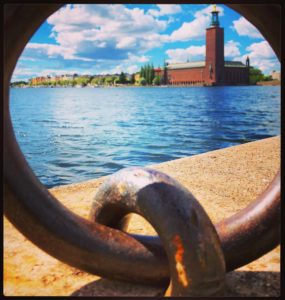
So, here are my top 7 tips for a short visit to Stockholm:
1. First stop: Gamla stan
Stockholm is situated on fourteen islands. The ’Old Town’, widely known as Gamla stan, consists primarily of the island Stadsholmen, as well as the neighboring islets Riddarholmen, Helgeandsholmen and Strömsborg. It is home to many important buildings and historical landmarks, such as to the Riksdagshuset (the Houses of Parliament), the Stockholm Cathedral (also known as Storkyrkan or Sankt Nikolai kyrka), the Riddarholm Church (the final resting place of most Swedish monarchs), the Nobel Museum, and the Royal Palace (the official residence of the Swedish monarch).
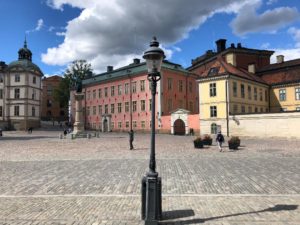
In Gamla stan, there are many cobblestoned alleyways, including Mårten Trotzigs gränd, which is the narrowest street in Stockholm; at its narrowest, the width is 90 cm.
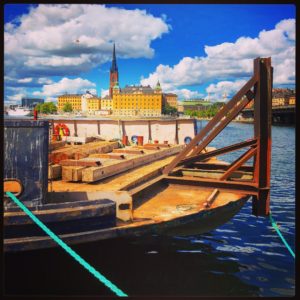
2. Fika & Salander: Södermalm
Gamla stan connects to Södermalm to the south by Slussen. Also known as Söder, this island is home to the Södra Teatern, the oldest theatre in Stockholm, and to the Swedish Museum of Photography (Fotografiska). Neither is far from Fiskargatan 9, where Lisbeth Salander lived (before she sold her apartment to Kadi Linder), or from Nytorget, where Catrin Lindås (a journalist that first appears in ‘The Girl Who Lived Twice’) lives.
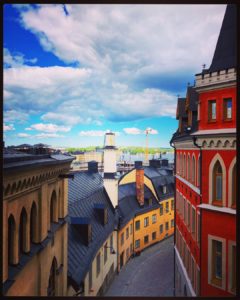
At this point, perhaps I should mention a few words about an essential part of the Swedish culture: fika. This refers to the coffee-breaks, that the Swedes take during their working days, usually mid-morning and/or mid-afternoon. It is an opportunity to refuel on coffee and perhaps a delicious cinnamon bun (kanelbullar), as well as to socialize. Perhaps this is one of the reasons why Sweden is one of the highest coffee consuming countries in the world.
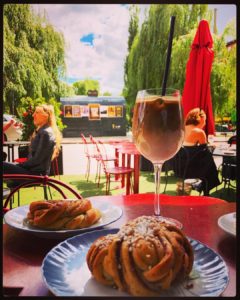
My fika trail in Södermalm
My fika trial started at Nytorget, a small square around which there are many cafés, bars and restaurants. I had brunch at the ‘Urban Deli’, coffee at ‘Gildas rum’ (a cozy cafe also serving delicious pastries), and dinner at ‘Nytorget 6’ (a lovely bar/restaurant serving Swedish food).
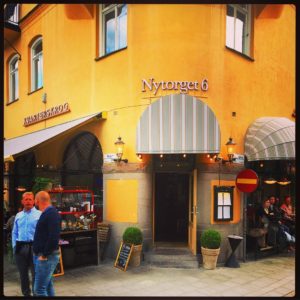
Around the corner from Nytorget, there are the ‘Café String’ (a cozy cafe on Nytorgsgatan), the ‘Meatballs for the People’ (a great place to try the world-famous Swedish meatballs, also on Nytorgsgatan), and the ‘Snotty Sound Bar’ (a small cocktail bar on Skånegatan).
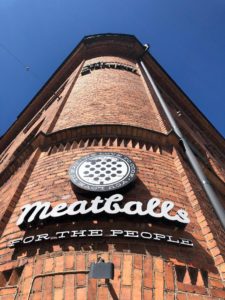
One of my favorite cafes, ‘Fikabaren’, was also in that area, but unfortunately it permanently closed earlier this year.
Also in Söder, there’s another favorite cafe of mine: ‘Johan & Nyström’. It is located on Swedenborgsgatan, a street lined up with cafes and restaurants. This is not the only ‘Johan & Nyström’; there are a few more locations in Stockholm, as well as elsewhere in Sweden.
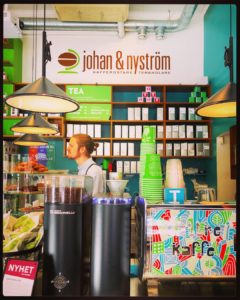
From Swedenborgsgatan, I walked past Mariatorget and all the way to ’Café Mariaberget’ at Bastugatan 19, the next stop in my fika trail in Södermalm. Not far from this cozy cafe, there are observation points offering views of the Gamla stan opposite. Mikael Blomkvist’s penthouse at Bellmansgatan 1 is not far from there either. Walking there, I stumbled across ’The Bishops Arms’, a non-fictional pub frequented by the fictional journalist. Even if you’re not as big a fan of the ‘Millennium’ series, it is worth going for a walk there, as this is one of the most beautiful places in Stockholm.
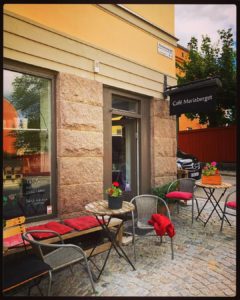
3. Fotografiska: The Swedish Museum of Photography
Also in Södermalm, there’s the Swedish Museum of Photography, widely known as Fotografiska. Housed in a former customs house, it is the largest photography museum in the world. The museum opened in 2010 and was the first Fotografiska to open. Its sister museums Fotografiska Tallinn and Fotografiska New York opened in 2019.
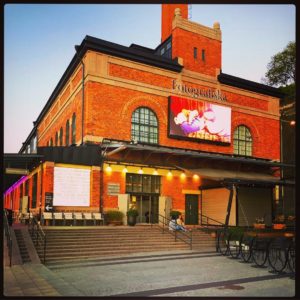
It features many exhibitions and is also home to a restaurant, located on the top floor and overlooking the Stockholm archipelago. In 2017, Fotografiska was awarded the Best Museum Restaurant in the World.
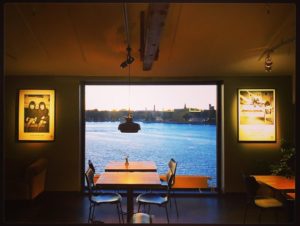
The museum is open until 11 pm every day and the ticket costs 170 kr.
4. Tunnelbana: The World’s Longest Art Gallery
Also known as Tunnelbana, the Stockholm Underground has 100 stations, half underground and half overground. All lines go through T-Centralen, which is the busiest station of all. It is right next to both the central bus station and the central train station.
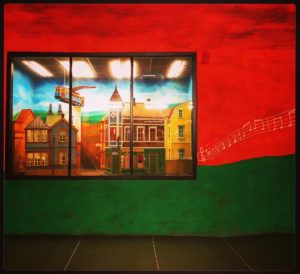
Whether you need to use public transport or not (at the end of the day, Stockholm is a very walkable city, especially in the summer when the weather’s good and the days long), I would strongly recommend taking the metro, and getting off the train at different stations. The Stockholm Underground is often referred to as the world’s longest art gallery, and for a very good reason. Most of the metro stations are works of art themselves. Each one is different, so it’s worth getting off to as many as possible.

My favorite ones are Kungsträdgården (on the blue line – featuring artwork by Ulrik Samuelson as well as Roman columns and sculptures), Solna Centrum (also on the blue line – painted in deep red and dark green colors by Anders Åberg and Karl-Olov Björk), and Stadion (on the red line – painted in the colors of the rainbow by Enno Hallek and Åke Pallarp). If you’re a fan of video games, you may also appreciate the Super Mario-inspired artwork by Lars Arrhenius at Thorildsplan station (on the green line).
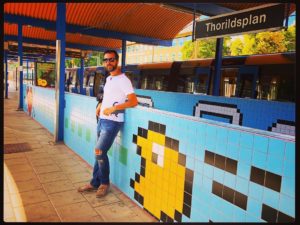
A single ticket costs 37 kr and is valid for 75 minutes. A 24-hour travelcard costs 155 kr, whereas a 72-hour one costs 310 kr.
5. The Winner Takes It All: ABBA The Museum
Sweden is the birthplace of a great number of pop musicians, including the pop singers Zara Larsson, Lykke Li and Robyn, Eurovision winners Elena Paparizou, Loreen and Måns Zelmerlöw, and DJs, such as Axwell, Sebastian Ingrosso, and the late Avicii. Famous Swedish bands include Ace of Base, the Cardigans and Roxette. But perhaps the most famous of all is ABBA, who became worldwide famous when they won the Eurovision Song Contest in 1974.
Nowadays, there is an entire museum dedicated to ABBA. I have not been there yet, but I will do so next time I visit Stockholm. ABBA The Museum is located on the island of Djurgården, which can be reached by foot, tram or boat (departing from several locations).
6. Fika & Jazz: Stockholm Jazz Festival
If you’re not a huge fan of pop music, then there may still be something for you. The Stockholm Jazz Festival takes place every October, and this year it is due from 9 to 18 October (COVID-19 permitting). Concerts will take place in over 60 venues around Stockholm. The line-up is yet to be announced.
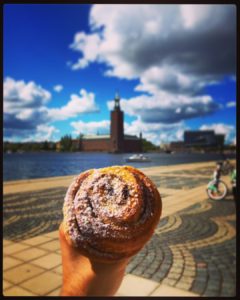
7. Beyond Bergman: Stockholm International Film Festival
Many Swedish films, filmmakers and actors have been worldwide famous, including the films by Ingmar Bergman, the renowned Swedish director. The actors Greta Garbo, Ingrid Bergman, Rebecca Ferguson and Alexander Skarsgård have all been born in Stockholm, whereas Alicia Vikander was born in Gothenburg. To find out more about Swedish cinema, you can visit Stockholm in November, when the Stockholm International Film Festival takes place. This year it is due from 11 to 22 November 2020; the program is yet to be announced.
How to get to Stockholm
There are four international airports near Stockholm. Arlanda is the main one and is located 40 km north of the city. From there, you can take the train or to the bus to Stockholm (T-Centralen).
Accommodation in Stockholm
When I last visited Stockholm, I stayed at an apartment I’d found on Airbnb. It was located in Södermalm, which is home to many hotels as well.
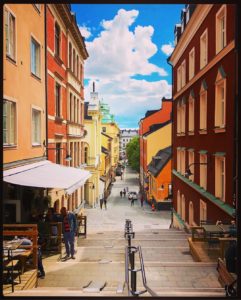
When to visit Stockholm
Late spring and summer is the best time to visit Stockholm (and Scandinavia in general), as the days are really long. However, the autumn is also a good time to visit the Swedish capital, either in October (for the jazz festival) or November (for the film festival).
Further reading
If you’re a fan of Scandinavian crime fiction, check out my post ‘Crime & Fjords: 9 Scandinavian writers you should read‘.
If you’d rather read about lagom and why the Scandinavians are amongst the happiest people in the world, check out my post ‘Hygge, Lagom & Lykke: 10 books about Scandi happiness’, or the following books about lagom and the Swedes:
Lagom: The Swedish Art of Balanced Living
Linnea Dunne, a Swedish writer now living in Dublin, Ireland, writes about work-life balance and environmentally conscious living, both aspects of a lagom lifestyle. She shares tips on how to achieve it, as well as a few recipes ideal for fika.
Lagom: The Swedish Secret of Living Well
Lola Åkerström, a Nigerian writer and photographer who previously lived in America and now lives in Sweden, describes lagom as ‘a way of living that promotes happiness and celebrates fairness, moderation and being satisfied with what you’ve got’. In her book, Åkerström often compares and contrasts lagom to the Law of Jante, a set of ten rules that appears in Aksel Sandemose’s novel ‘A Fugitive Crosses His Tracks’.
The Swedes: A Happy Culture of Scandinavia
In this beautifully illustrated book, Julien S. Burrelle uses his sense of humour to help introduce the reader to the Swedish (and Scandinavian) psyche and social etiquette.
The Almost Nearly Perfect People: Behind the Myth of the Scandinavian Utopia
Michael Booth explores the secrets to Scandinavian success and happiness, but also sheds light on the darker corners of Nordic societies, where taboos, parochialism and extremism flourish.
You might also want to check out my post ‘Sweden: Behind the myth of the lagom utopia‘.
If you’d rather read about traveling, check out my tips for Oslo.
My tips for Copenhagen will be published very soon (hopefully next Saturday)!
Stay safe!
Alex
(the London-based Traveling Psychiatrist)
One Comment
Pingback: